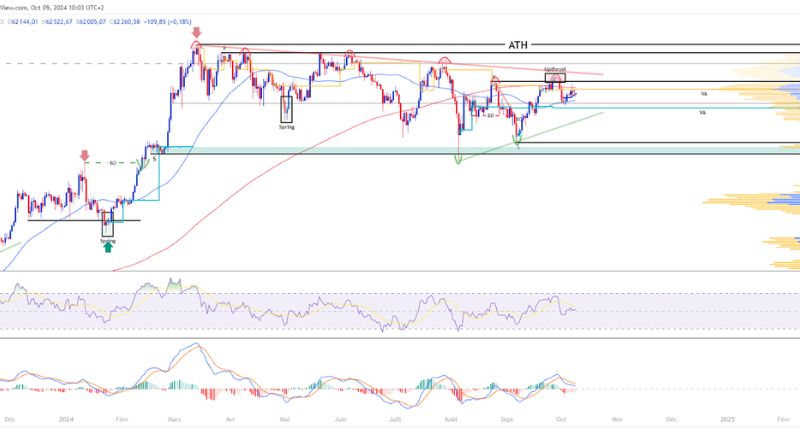Bitcoin (BTC), as one of the most influential cryptocurrencies in the world, has attracted widespread attention for its price fluctuations in recent years. From breaking through the $10000 mark in 2017 to climbing to a high of nearly $60000 in 2021, the rapid rise in Bitcoin prices reflects the significant changes in the market and the interweaving of multiple factors. This article will delve into the market trends and reasons behind the rise in Bitcoin prices from $10000 to $60000, helping readers better understand this wave of price fluctuations.
Looking back at the history of Bitcoin, in December 2017, BTC broke through $10000 for the first time, marking an important milestone. However, this price did not last long and immediately entered the bear market of 2018. Nevertheless, Bitcoin has always attracted the attention of investors, and its unique decentralized nature and scarcity have given the market confidence in its long-term investment.
In 2020, Bitcoin experienced a significant price rebound. In March 2020, due to the global outbreak of the pandemic and stock market turbulence, the price of Bitcoin plummeted for a while, but then experienced a strong rebound. In 2021, the price of Bitcoin surpassed $60000 in March, becoming the focus of global investors’ attention. This wave of price increases is the result of multiple factors working together, including the entry of institutional investors, changes in the macroeconomic environment, and the gradual recognition of Bitcoin as a safe haven asset.
In 2017, Bitcoin was mainly dominated by scattered retail investors, with significant price fluctuations and relatively unstable market conditions. However, since 2020, the influx of institutional investors has become an important driving force behind the rise in Bitcoin prices. Many traditional financial giants have begun to enter the cryptocurrency market, with companies such as Tesla and MicroStrategy including Bitcoin as part of their balance sheets. Especially when Tesla announced the purchase of $1.5 billion in Bitcoin, this move undoubtedly injected a strong signal into the market, indicating that Bitcoin is no longer just a speculative commodity and is gradually moving towards the mainstream asset class.
At the same time, an increasing number of institutional investors are participating in the Bitcoin market through methods such as Bitcoin ETFs (exchange traded funds), further enhancing market liquidity and stability. The participation of institutions has led to the maturity of the Bitcoin market, and as a result, the btc price has shown a stronger upward trend.
The rise in Bitcoin price is inseparable from the impact of the global macroeconomic environment. Especially in 2020, the monetary easing policy and large-scale fiscal stimulus measures implemented worldwide due to the COVID-19 promoted the devaluation of traditional currencies. This has led to a decrease in investors’ confidence in the US dollar and other fiat currencies, resulting in a significant increase in demand for digital assets such as Bitcoin.
As a decentralized, limited supply asset, Bitcoin is seen as a tool to hedge against inflation. Unlike the unlimited issuance of fiat currency, the total amount of Bitcoin is limited to 21 million, which makes Bitcoin regarded by many investors as a “digital gold” or safe haven asset. Therefore, against the backdrop of the depreciation of the US dollar, more and more capital is beginning to flow into the Bitcoin market, driving its price up.
In addition to the entry of institutional investors, the rise of decentralized finance (DeFi) and non fungible tokens (NFT) has also driven up the price of Bitcoin. DeFi is a series of decentralized financial applications based on blockchain technology, which can provide financial services such as lending, trading, and savings without intermediaries. With the rise of DeFi platforms, more and more users and developers are paying attention to cryptocurrencies, especially mainstream cryptocurrencies such as Bitcoin, which greatly increases the market demand for Bitcoin.
In addition, the rise of NFTs has also had an indirect impact on the Bitcoin market. As a blockchain based digital asset, NFT does not directly rely on Bitcoin, but its booming market has attracted more investors to enter the field of encrypted assets. These investors often invest some of their funds in Bitcoin, further driving up the price of Bitcoin.
Despite the significant increase in Bitcoin prices, the market still faces certain risks. Firstly, as a relatively emerging asset class, the uncertainty of regulatory policies for Bitcoin has always been a significant issue. Governments of different countries have varying attitudes towards cryptocurrencies, with some countries such as China having implemented strict regulatory measures, while others may adopt more lenient policies. If regulation becomes stricter globally, it may have a negative impact on the price of Bitcoin.
Secondly, the sharp fluctuations in the price of Bitcoin also triggered concerns about the market foam. Despite the continuous rise in the value of Bitcoin, its price volatility remains significant, causing many investors to express concerns about the long-term stability of the market. Once there is a market correction or significant negative news, the price of Bitcoin may quickly fall back.
The price increase of Bitcoin from $10000 to $60000 is due to the combined effects of institutional investors, macroeconomic environment, market demand, and decentralized finance. Although Bitcoin has shown strong growth potential in some aspects, the volatility of its price and the uncertainty of regulatory policies remain key factors affecting its future trend. For investors, understanding these market trends and potential risks will help evaluate the investment value of Bitcoin more rationally.
MAY YOU LIKE :Exploring Entertech.org A Hub for Technology Enthusiasts











Leave a Reply